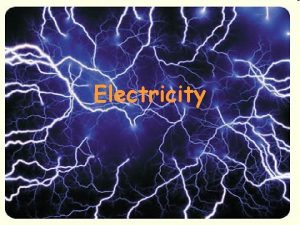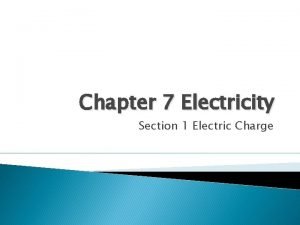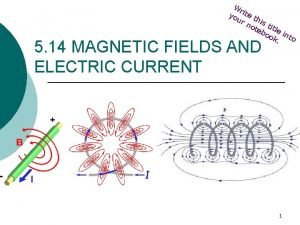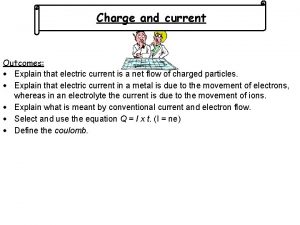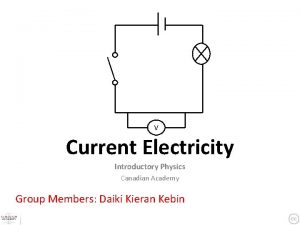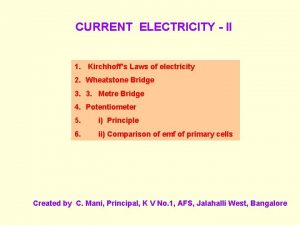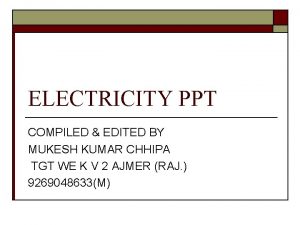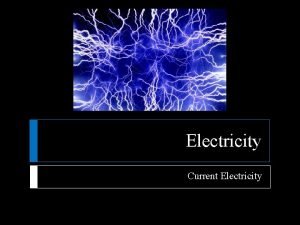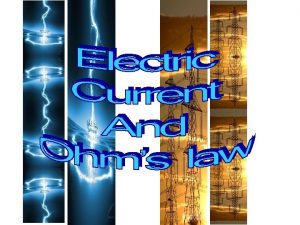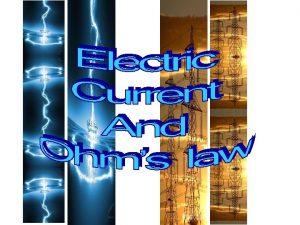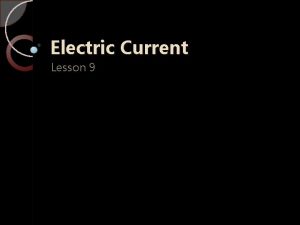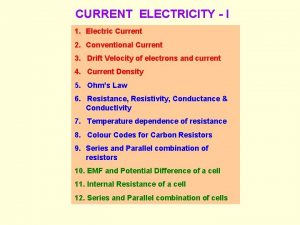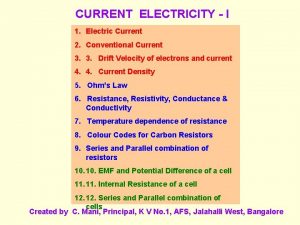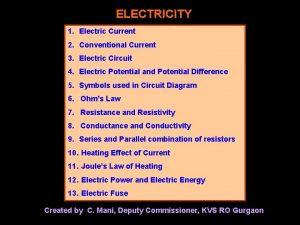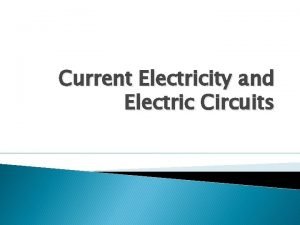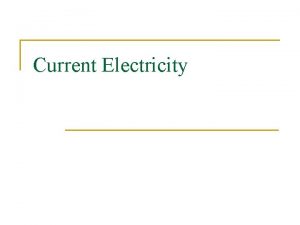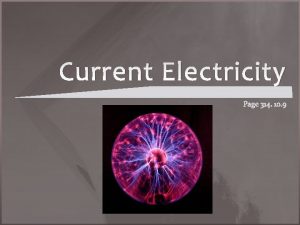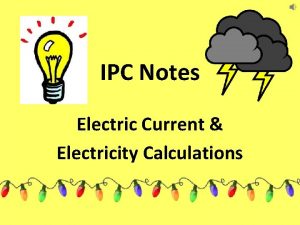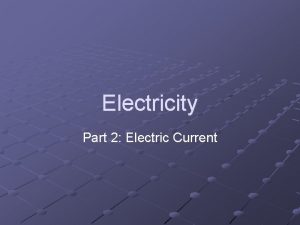CURRENT ELECTRICITY I 1 Electric Current 2 Conventional




















- Slides: 20

CURRENT ELECTRICITY - I 1. Electric Current 2. Conventional Current 3. Drift Velocity of electrons and current 4. Current Density 5. Ohm’s Law 6. Resistance, Resistivity, Conductance & Conductivity 7. Temperature dependence of resistance 8. Colour Codes for Carbon Resistors 9. Series and Parallel combination of resistors 10. EMF and Potential Difference of a cell 11. Internal Resistance of a cell 12. Series and Parallel combination of cells

Electric Current: The electric current is defined as the charge flowing through any section of the conductor in one second. I=q/t (if the rate of flow of charge is steady) I = dq / dt (if the rate of flow of charge varies with time) Different types of current: a) Steady current which does not vary with time I a b) & c) Varying current whose magnitude varies with time d) Alternating current whose magnitude varies continuously and direction changes periodically b c d 0 t

Conventional Current: + + Conventional current due to motion of electrons is in the direction opposite to that of motion of electrons. Drift Velocity and Current: Drift velocity is defined as the velocity with which the free electrons get drifted towards the positive terminal under the effect of the applied electric field. vd = a τ vd = - (e. E / m) τ I = ne. A vd + + + I - Conventional current is the current whose direction is along the direction of the motion of positive charge under the action of electric field. - - - I + + l A vd - - - E I Current is directly proportional to drift velocity. vd - drift velocity, a – acceleration, τ – relaxation time, E – electric field, e – electronic charge, m – mass of electron, n – number density of electrons, l – length of the conductor and A – Area of cross-section

Current density: Current density at a point, within a conductor, is the current through a unit area of the conductor, around that point, provided the area is perpendicular to the direction of flow of current at that point. J = I / A = nevd In vector form, I = J. A Ohm’s Law: The electric current flowing through a conductor is directly proportional to the potential difference across the two ends of the conductor when physical conditions such as temperature, mechanical strain, etc. remain the same. I IαV or V α I or V = R I I 0 V V

Resistance: The resistance of conductor is the opposition offered by the conductor to the flow of electric current through it. R=V / I Resistance in terms of physical features of the conductor: I = ne. A | vd | R =ρ I = ne. A (e |E| / m) τ ne 2 Aτ V I= m l V I = R = ml ne 2 Aτ m l ne 2τ A l A where ρ = m ne 2τ is resistivity or specific resistance Resistance is directly proportional to length and inversely proportional to cross-sectional area of the conductor and depends on nature of material. Resistivity depends upon nature of material and not on the geometrical dimensions of the conductor.

Relations between vd , ρ, l, E, J and V: ρ = E / J = E / nevd (since, J = I / A = nevd ) vd = E /(neρ) (since, E = V / l ) vd = V /(neρl) When temperature increases, vd decreases and ρ increases. When l increases, vd decreases. Conductance and conductivity: Conductance is the reciprocal of resistance. Its S. I unit is mho. Conductivity is the reciprocal of resistivity. Its S. I unit is mho / m. Temperature dependence of Resistances: R = m When temperature increases, the no. of collisions increases due to more internal energy and relaxation time decreases. Therefore, Resistance increases. l ne 2τ A Temperature coefficient of Resistance: α= Rt – R 0 t or α= R 2 – R 1 t 2 – R 2 t 1 If R 2 < R 1, then α is – ve. R 0 – Resistance at 0°C Rt – Resistance at t°C R 1 – Resistance at t 1°C R 2 – Resistance at t 2°C

Colour code for carbon resistors: The first two rings from the end give the first two significant figures of resistance in ohm. B V B Gold 17 x 100 = 17 ± 5% Ω The third ring indicates the decimal multiplier. The last ring indicates the tolerance in per cent about the indicated value. Eg. AB x 10 C ± D % ohm Colour G R B Silver 52 x 106 ± 10% Ω Letter Colour Number Tolerance B Black 0 Gold 5% B Brown 1 Silver 10% R Red 2 No colour 20% O Orange 3 Y Yellow 4 G Green 5 B Blue 6 V Violet 7 G Grey 8 W White 9 BVB 52 x 100 = 52 ± 20% Ω B B ROY of Great Britain has Very Good Wife

Another Colour code for carbon resistors: i) The colour of the body gives the first significant figure. Red Ends ii) The colour of the ends gives the second significant figure. iii) The colour of the dot gives the decimal multipier. iv) The colour of the ring gives the tolerance. Yellow Body Gold Ring Blue Dot YRB Gold 42 x 106 ± 5% Ω Series combination of resistors: R = R 1 + R 2 + R 3 R 1 R 2 R 3 R is greater than the greatest of all. Parallel combination of resistors: R 1 R 2 R 3 1/R =1/R 1 + 1/R 2 + 1/R 3 R is smaller than the smallest of all.

Sources of emf: The electro motive force is the maximum potential difference between the two electrodes of the cell when no current is drawn from the cell. Comparison of EMF and P. D: EMF Potential Difference 1 EMF is the maximum potential difference between the two electrodes of the cell when no current is drawn from the cell i. e. when the circuit is open. P. D is the difference of potentials between any two points in a closed circuit. 2 It is independent of the resistance of the circuit. It is proportional to the resistance between the given points. 3 The term ‘emf’ is used only for the source of emf. It is measured between any two points of the circuit. 4 It is greater than the potential difference between any two points in a circuit. However, p. d. is greater than emf when the cell is being charged.

Internal Resistance of a cell: The opposition offered by the electrolyte of the cell to the flow of electric current through it is called the internal resistance of the cell. Factors affecting Internal Resistance of a cell: i) Larger the separation between the electrodes of the cell, more the length of the electrolyte through which current has to flow and consequently a higher value of internal resistance. ii) Greater the conductivity of the electrolyte, lesser is the internal resistance of the cell. i. e. internal resistance depends on the nature of the electrolyte. iii) The internal resistance of a cell is inversely proportional to the common area of the electrodes dipping in the electrolyte. iv) The internal resistance of a cell depends on the nature of the electrodes. E =V+v E r = IR + Ir = I (R + r) I = E / (R + r) I v R This relation is called circuit equation. V I

Internal Resistance of a cell in terms of E, V and R: E =V+v = V + Ir Ir = E - V E r v I R Dividing by IR = V, Ir E–V = IR I E r =( V - 1) R V V Determination of Internal Resistance of a cell by voltmeter method: + V + r V r I R. B (R) K Open circuit (No current is drawn) K Closed circuit (Current is drawn) EMF (E) is measured Potential Difference (V) is measured

Cells in Series combination: Cells are connected in series when they are joined end to end so that the same quantity of electricity must flow through each cell. NOTE: E r 1. The emf of the battery is the sum of the individual emfs 2. The current in each cell is the same and is identical with the current in the entire arrangement. E r I I R V 3. The total internal resistance of the battery is the sum of the individual internal resistances. Total emf of the battery = n. E (for n no. of identical cells) Total Internal resistance of the battery = nr Total resistance of the circuit = nr + R (i) If R << nr, then I = E / r (ii) If nr << R, then I = n (E / R) Current I = n. E nr + R Conclusion: When internal resistance is negligible in comparison to the external resistance, then the cells are connected in series to get maximum current.

Cells in Parallel combination: Cells are said to be connected in parallel when they are joined positive to positive and negative to negative such that current is divided between the cells. E r NOTE: 1. The emf of the battery is the same as that of a single cell. E r 2. The current in the external circuit is divided equally among the cells. 3. The reciprocal of the total internal resistance is the sum of the reciprocals of the individual internal resistances. Total emf of the battery = E Total Internal resistance of the battery = r / n Total resistance of the circuit Current I = n. E n. R + r I E r R V = (r / n) + R (i) If R << r/n, then I = n(E / r) (ii) If r/n << R, then I = E / R Conclusion: When external resistance is negligible in comparison to the internal resistance, then the cells are connected in parallel to get maximum current. I

CURRENT ELECTRICITY - II 1. Kirchhoff’s Laws of electricity 2. Wheatstone Bridge 3. Metre Bridge 4. Potentiometer i) Principle ii) Comparison of emf of primary cells

KIRCHHOFF’S LAWS: I Law or Current Law or Junction Rule: The algebraic sum of electric currents at a junction in any electrical network is always zero. I 2 I 1 I 3 I 5 Sign Conventions: I 1 - I 2 - I 3 + I 4 - I 5 = 0 O I 4 1. The incoming currents towards the junction are taken positive. 2. The outgoing currents away from the junction are taken negative. Note: The charges cannot accumulate at a junction. The number of charges that arrive at a junction in a given time must leave in the same time in accordance with conservation of charges.

II Law or Voltage Law or Loop Rule: The algebraic sum of all the potential drops and emf’s along any closed path in an electrical network is always zero. I 1 E 1 R 1 Loop ABCA: A B - E 1 + I 1. R 1 + (I 1 + I 2). R 2 = 0 R 2 I 1 + I 2 I 1 Loop ACDA: C D - (I 1 + I 2). R 2 - I 2. R 3 + E 2 = 0 R 3 I 2 E I 2 2 Sign Conventions: 1. The emf is taken negative when we traverse from positive to negative terminal of the cell through the electrolyte. 2. The emf is taken positive when we traverse from negative to positive terminal of the cell through the electrolyte. The potential falls along the direction of current in a current path and it rises along the direction opposite to the current path. 3. The potential fall is taken negative. 4. The potential rise is taken positive. Note: The path can be traversed in clockwise or anticlockwise direction of the loop.

B Wheatstone Bridge: P Currents through the arms are assumed by applying Kirchhoff’s Junction Rule. Applying Kirchhoff’s Loop Rule for: I 1 G C S R I I - I 1 + Ig D When Ig = 0, the bridge is said to balanced. By manipulating the above equations, we get I 1 - Ig Ig A Loop ABDA: -I 1. P - Ig. G + (I - I 1). R = 0 Loop BCDB: - (I 1 - Ig). Q + (I - I 1 + Ig). S + Ig. G = 0 Q I E P R Q S I I

Metre Bridge: R. B (R) X Metre Bridge is based on the principle of Wheatstone Bridge. G A B l cm When the galvanometer current is made zero by adjusting the jockey position on the metrebridge wire for the given values of known and unknown resistances, J 100 - l cm K E R RAJ R X RJB X Therefore, X = R (100 – l) ⁄ l l 100 - l (Since, Resistance α length)

I Potentiometer: E Principle: V=IR A = I ρl/A If the constant current flows through the potentiometer wire of uniform cross sectional area (A) and uniform composition of material (ρ), then V = Kl or + A V 0 l cm J 100 200 + 300 Rh B 400 K Vαl V /l is a constant. The potential difference across any length of a wire of uniform cross-section and uniform composition is proportional to its length when a constant current flows through it. V 0 l

Comparison of emf’s using Potentiometer: The balance point is obtained for the cell when the potential at a point on the potentiometer wire is equal and opposite to the emf of the cell. E 1 = VAJ 1 = I ρl 1 /A E 2 = VAJ 2 = I ρl 2 /A E 1 / E 2 = l 1 /l 2 E 1 I E A A + + + E 2 0 B G l 2 J 2 l 1 200 Rh R. B 100 J 1 300 400 K Note: The balance point will not be obtained on the potentiometer wire if the fall of potential along the potentiometer wire is less than the emf of the cell to be measured. The working of the potentiometer is based on null deflection method. So the resistance of the wire becomes infinite. Thus potentiometer can be regarded as an ideal voltmeter.
 Static electricity and current electricity
Static electricity and current electricity Current electricity
Current electricity Magnetism vocabulary
Magnetism vocabulary Electricity section 1 electric charge
Electricity section 1 electric charge Electricity section 1 electric charge
Electricity section 1 electric charge Chapter 6 electricity section 1 electric charge answers
Chapter 6 electricity section 1 electric charge answers Yo teb
Yo teb Magnetic levitation formula
Magnetic levitation formula Conventional current direction
Conventional current direction What is current electricity in physics
What is current electricity in physics Electricity def
Electricity def Formula for venn diagram with 3 circles
Formula for venn diagram with 3 circles Bill nye current electricity
Bill nye current electricity Form of electricity
Form of electricity Current electricity
Current electricity Electrons flowing
Electrons flowing Current electricity ppt
Current electricity ppt Electric charges and electric forces lesson outline
Electric charges and electric forces lesson outline Electric potential energy definition
Electric potential energy definition Chapter 21 electric charge and electric field
Chapter 21 electric charge and electric field Electric potential electric field
Electric potential electric field



